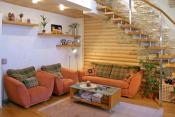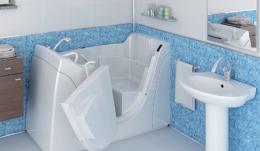Search
Login
Recommended
Disabled bathroom, bathroom amenities
In all civilized countries, lately, more attention has been paid to the problems of people with limited mobility. Today, people with disabilities in terms of movement can often be seen on the streets of big cities - if earlier such a person simply had to be at home, today there are more acceptable conditions for moving him around the city - state programs to help people with disabilities are aimed at creating an environment friendly to them .
Content:
- People with limited mobility who belong to this category
- The equipment of bathrooms for disabled people
- How to properly place a shower and toilet video
- What equipment should be used in the bathroom
- Floors and wiring in bathrooms
People with limited mobility who belong to this category
There are not so few people who belong to the category of people with limited mobility, this is about 10% of the country's population, they include not only disabled people, this group includes:
- people with temporary health problems, especially those who have lost the ability to move on their feet or to freely navigate in space,
- women in late pregnancy,
- elderly people.

The tasks of facilitating the lives of people with disabilities are not only in the additional amenities that they can use on the street, hospital or store - it is very important to establish the home life of people with limited mobility with maximum comfort. In particular, this concerns the creation of additional conditions in sanitary-hygienic rooms. They should be equipped in accordance with the list of rules and requirements that are taken into account when designing structures.
The equipment of bathrooms for disabled people
The requirements primarily apply to the size of the bathroom cubicle - it should have larger dimensions than usual, the dimensions for a standard wheelchair are taken as the basis for calculations. Sometimes, calculating the dimensions, they are repelled from the sizes of more comfortable strollers, but at the same time their length should not exceed 1200 mm, width - 700 mm.

It is also necessary to provide for the possibility of:
- pivot stroller
- convenient for the disabled approach to the sanitary device,
- the presence of a swivel chair at shower.
The optimum installation height for the disabled washbasin is 0, 85 m from the floor. The top of the toilet seat should be at a height of half a meter from the floor - in this case, the seat will match the level of the wheelchair.
Given the problems and the nature of the disease, a person should be allocated a room that is as close as possible to the sanitary facility. Depending on the same factors, the bathroom for the disabled should be equipped with certain models of plumbing. The bathroom itself should be as free as possible, there should not be extra objects in it - this will make it possible to move freely.
If you approach the issue from the point of view of rationality, then the combined bathroom will be more suitable for a disabled person. It is desirable that its dimensions are not less than 2.3 x 2.3 m.
All sockets and switches should be at a level convenient for the disabled person, it is also advisable to think over a variant of the warning system - in the event of a fall or some emergency, a person should be able to use the means of communication, being in any position anywhere in the bathroom.
How to properly place a shower and toilet
Mandatory items, the installation of which should be planned in the bathroom are:
- a shower cabin for the disabled, or a special bathtub,
- toilet,
- washbasin.
If a person is not able to get up from the stroller, the best option would be a shower cabin without a tray, i.e. It is advisable to create the ability to call in a shower in a wheelchair. The dimensions of the door must match the width of the stroller. The dimensions of the cabin, at least, should be 1.4 x 1.4 m. It is advisable to arrange the shower cubicle as close as possible to the toilet.
As for the toilet, it is advisable to choose a place for its installation so that the approach and wheelchair access to it is possible from all sides. The ideal option is if you can enter the room in a wheelchair without turning around, and drive from the entrance to the bathroom or toilet from the side.
It is advisable to select special models of toilets equipped with folding armrests. The anodized aluminum used to make the armrests is very durable and can withstand loads of up to 300 kg. If older people suffer from knee diseases, then you can pick up a special toilet bowl with a higher height. You can use the simpler option - purchase a special pad on the toilet seat, which will significantly increase its height.

To avoid any extreme situations, complicated by the threat of injury, you should take care of high-quality lighting. Each of the switches must be at such a level that you can use it while sitting on a wheelchair, you can not place them behind shelves or cabinets - reaching the switch while sitting in a wheelchair is dangerous.
One of the options for the equipment of the bathroom, the most convenient for the disabled can be seen when watching the video:
What equipment should be used in the bathroom
Furnishing a bathroom for a disabled person will require the installation of special equipment to facilitate daily hygiene. Of course, not every disabled person needs all the devices, but some of the devices can greatly facilitate the life of people with disabilities.

Among the most useful modern developments are:
- chairs and lifts,
- handrails for the disabled in the bathrooms,
- steps and sinks
- baths for the disabled with a door.
Each of these devices should be considered in more detail.
hoisting gears
They will undoubtedly be needed by a person who, due to the disease, has lost the ability to get up and walk, in particular, such problems can occur in people who have suffered serious injuries, in athletes who go through a rehabilitation period.

The lift will facilitate the lifting of a non-walking person from a bed or a stroller, with its help it will be possible to lower the disabled person into the bathroom bowl before bathing. Anyone who has had to care for bedridden patients knows how difficult, and sometimes even impossible, to raise another person on their own, especially if you have to deal with it every day.
Nowadays, you can purchase complex, programmable models, but there are also simple, more affordable devices.
About how the lift works, watch the video:
a bathroom for disabled people - with what handrails to equip it
Around the perimeter, the bathroom should be equipped with handrails - this will greatly simplify the implementation of daily hygiene procedures.

Handrails for the bathroom for the disabled should have the following properties:
- have a secure fit
- the surface of the handles must not slip even when wet
- the diameter of the handles should be comfortable to grip and range from 25 to 33 mm.
Convenient handrails will help a person to independently rise, pull himself up to the necessary subject, and will also work as a kind of simulator, helping to maintain physical fitness. For the manufacture of handrails using metals or a combination of metal with plastic.
In the bathroom for the disabled, you can use:
- rotary
- folding,
- stationary handrails.
steps with support leg

They will be needed if the bath in the bathroom is used ordinary. With the help of this device, it will be much easier for a person with impaired motor system to overcome the side of the bathroom. Steps are made of non-slippery materials, most often equipped with handrails.
bathtubs for disabled people with a door
The option with steps and using a regular bath does not always give the desired results - it is still difficult for a disabled person to get into the bath. A more rational solution would be to install a special bathtub for the disabled, with a sealed door. Since this product is quite specific and is not in high demand, we are not talking about mass production. Small volumes of production lead to a rather high cost of goods.

But if financial opportunities allow it - it makes sense to invest in such a bath:
- it’s extremely comfortable for people with reduced mobility,
- opening the bathroom door is very easy,
- the presence of the handle handles makes it possible to control the balance and allows you to safely enter the bath,
- the presence of doors eliminates the need for a sick person to raise his leg high and bend it at the knee - in order to get into the bath you will need to take a small step - approximately like on an ordinary step,
- the presence in the bath seat allows a comfortable reception of water procedures.
The unique design of this type of bathtub is protected by a world patent. You can watch more details about these original bathtubs in the video:
disabled sinks
Today's fashion for sanitary products involves the installation of sinks with a horizontal siphon connection. This option allows the installation of a washing machine with front loading of laundry directly under the sink. Similar models are suitable for installation in the bathroom for a disabled person - they allow you to drive a stroller close to the sink.
No less convenient will be models with an ergonomic, concave inward leading edge - it will be convenient to rest against such a sink when washing.

The sink can be considered ideal in design, the angle of the slope of which can be adjusted by the patient himself, in accordance with his height and needs. A sink is especially convenient if a disabled child has to use it.
It is not possible to find such equipment and plumbing in every store, in most cases specialized companies are engaged in its implementation and they work in large cities. However, if desired, it will be easy to place an order with delivery to any city or village. In addition, distributors of such products offer quality installation services. Ultimately, it is important not only to acquire devices that are useful for the lives of people with disabilities, but also to use them as efficiently as possible.
Floors and wiring in bathrooms
It will be necessary to pay attention to the finish of the floors - it should have a corrugated or anti-slip, rough surface. When wet, the finishing material should remain non-slippery - often it is the wet floor in the bathroom that causes household injuries.
Laying of electric cables should be performed in such a way as to exclude the possibility of accidental contact with conductive elements.
The edges of the furniture in the bathroom should be rounded, preferably with special protective coatings.

Over the past decade, almost all facilities and infrastructures under construction have been equipped with sets of plumbing equipment designed for people with limited mobility. There are many methods to simplify the lives of people who have lost their health and mobility, the main thing is to carry out the correct selection of devices that would correspond to the nature of the disease of the disabled person and his physical capabilities.





